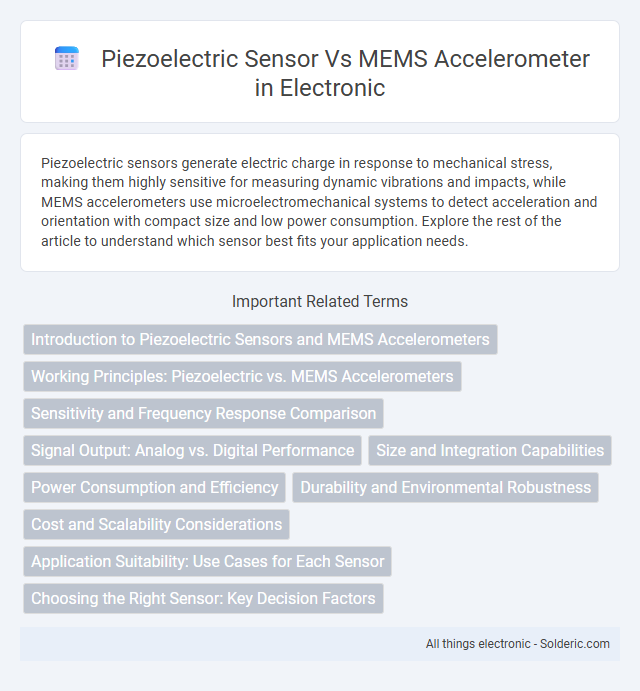Piezoelectric sensors generate electric charge in response to mechanical stress, making them highly sensitive for measuring dynamic vibrations and impacts, while MEMS accelerometers use microelectromechanical systems to detect acceleration and orientation with compact size and low power consumption. Explore the rest of the article to understand which sensor best fits your application needs.
Comparison Table
| Feature | Piezoelectric Sensor | MEMS Accelerometer |
|---|---|---|
| Sensing Principle | Piezoelectric effect (charge generation under mechanical stress) | Capacitive or piezoresistive sensing of acceleration |
| Measurement | Dynamic force, vibration, pressure | Static and dynamic acceleration, tilt |
| Frequency Response | High frequency (up to MHz range) | Lower frequency (up to kHz range) |
| Output Signal | Charge or voltage signal | Voltage or digital output |
| Sensitivity | High sensitivity to dynamic changes | Moderate sensitivity for static and dynamic acceleration |
| Size | Variable, typically larger | Micro-scale, compact |
| Power Consumption | Passive device, no external power needed for sensing | Requires power for operation |
| Applications | Vibration monitoring, structural health, impact detection | Motion tracking, tilt sensing, consumer electronics |
| Cost | Generally higher for high-end sensors | Cost-effective for mass production |
Introduction to Piezoelectric Sensors and MEMS Accelerometers
Piezoelectric sensors convert mechanical stress into electrical signals using materials like quartz or ceramics, making them ideal for measuring dynamic changes in pressure, acceleration, or force. MEMS accelerometers utilize microelectromechanical systems technology to detect acceleration by measuring changes in capacitance or piezoresistive elements within a tiny chip, offering precise, low-power motion detection. Your choice between these sensors depends on the application's frequency response, sensitivity, and environmental conditions.
Working Principles: Piezoelectric vs. MEMS Accelerometers
Piezoelectric sensors generate electrical charge in response to mechanical stress through the piezoelectric effect, making them ideal for dynamic force, vibration, and pressure measurements. MEMS accelerometers use microelectromechanical systems to detect acceleration by measuring the displacement of a suspended proof mass relative to its frame, often leveraging capacitive sensing. Your choice depends on whether you require high-frequency dynamic response (piezoelectric) or low-frequency acceleration and tilt sensing with integrated electronics (MEMS).
Sensitivity and Frequency Response Comparison
Piezoelectric sensors typically exhibit high sensitivity to dynamic acceleration and operate effectively within a broad frequency range, often from a few Hz up to several kHz, making them ideal for vibration and impact measurements. MEMS accelerometers provide moderate sensitivity with a narrower frequency response, generally up to a few hundred Hz, suited for low-frequency motion and tilt detection. The inherent material properties of piezoelectric crystals allow for superior frequency response, while MEMS devices excel in compact integration and DC or near-DC acceleration measurement.
Signal Output: Analog vs. Digital Performance
Piezoelectric sensors generate analog voltage signals proportional to mechanical stress, offering high sensitivity and wide frequency response suitable for dynamic measurements. MEMS accelerometers produce digital output through integrated analog-to-digital converters, enabling easy integration with microcontrollers and enhanced noise immunity. The analog output of piezoelectric sensors requires external signal conditioning, whereas MEMS accelerometers provide ready-to-use digital data, facilitating precise motion detection and complex signal processing.
Size and Integration Capabilities
Piezoelectric sensors typically offer compact size but MEMS accelerometers excel with even smaller footprints and superior integration capabilities on semiconductor chips. MEMS accelerometers can be easily embedded into complex electronics and IoT devices due to their microfabrication process, enhancing your ability to create multifunctional, space-constrained systems. Their scalability in production allows for high-volume applications, making MEMS accelerometers a preferred choice for modern, miniaturized sensing solutions.
Power Consumption and Efficiency
Piezoelectric sensors consume minimal power by generating electrical charge in response to mechanical stress without requiring an external power source, making them highly efficient for energy harvesting applications. MEMS accelerometers, however, rely on active electronic components that draw continuous power to measure acceleration accurately, resulting in higher power consumption. Your choice depends on whether low power consumption or precise multi-axis motion detection is more critical for your application.
Durability and Environmental Robustness
Piezoelectric sensors exhibit exceptional durability due to their simple, solid-state design and ability to withstand high temperatures and mechanical shocks, making them ideal for harsh industrial environments. MEMS accelerometers offer robust environmental stability with integrated temperature compensation and resilience to vibration and moisture, but they can be more sensitive to long-term drift and electronic noise. Your choice depends on specific application demands for ruggedness versus precision performance under varying environmental conditions.
Cost and Scalability Considerations
Piezoelectric sensors typically offer lower initial costs and simpler manufacturing processes, making them more cost-effective for large-scale deployment in applications requiring vibration or pressure detection. MEMS accelerometers, while initially more expensive due to complex semiconductor fabrication, benefit from high scalability and integration capabilities, reducing per-unit cost significantly in high-volume production. Understanding your project's scale and budget constraints helps determine whether the cost-efficiency of piezoelectric sensors or the scalable precision of MEMS accelerometers better suits your needs.
Application Suitability: Use Cases for Each Sensor
Piezoelectric sensors excel in high-frequency vibration monitoring and impact detection, making them ideal for structural health monitoring and industrial machinery diagnostics. MEMS accelerometers are preferred for low-frequency motion sensing, tilt measurement, and consumer electronics applications such as smartphones and wearable devices. Your choice depends on whether you require sensitivity to dynamic changes (piezoelectric) or precise static and dynamic acceleration data (MEMS).
Choosing the Right Sensor: Key Decision Factors
Choosing the right sensor involves evaluating sensitivity, frequency response, and application environment; piezoelectric sensors excel in high-frequency vibration detection and harsh conditions, while MEMS accelerometers offer versatile, compact solutions with low power consumption and wide dynamic range. Your decision should consider measurement accuracy, size constraints, and signal processing needs to match the sensor's characteristics with the specific application requirements. Prioritizing these factors ensures optimal performance and reliability in your motion or vibration monitoring system.
piezoelectric sensor vs MEMS accelerometer Infographic

 solderic.com
solderic.com